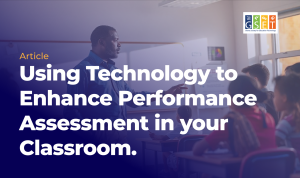
GSET Blogs
The 5Es of Impact and the 5Es of GSET: Scaling EdTech with Global Purpose
Written By Miracule Gavor and Natalia Kucirkova

In the bustling world of educational technology (EdTech), where innovation races ahead at breakneck speed, it’s crucial to pause and consider: Are we truly making a difference in learners’ lives across the globe? From the tech hubs of Silicon Valley to the remote classrooms of rural Africa, the promise of EdTech echoes. But how do we ensure that this promise translates into meaningful impact for all?
The Power of Five: A Universal Language
Humans are naturally drawn to the number five—our five fingers and toes, for example, often shape how we organize ideas and models. Like the points of a star, frameworks with five elements give us a sense of balance and wholeness. It’s no surprise that many influential models across cultures are built around this number. From the Five Pillars of Islam to the Five Elements in Chinese philosophy, the number five resonates globally as a symbol of completeness.
In the realm of education and technology, this universal appeal of ‘five’ has found a new expression. In March 2023, Kucirkova proposed the 5Es model to evaluate the impact of educational resources, particularly EdTech. This model synthesizes and consolidates multiple competing frameworks and tools, providing a clear and comprehensive approach to assessing the effectiveness of educational technologies across diverse global contexts.
The 5Es: A Global Lens for EdTech Impact
The Framework draws on existing evaluation frameworks across five impact domains to create a holistic approach. It was developed through a systematic review of the literature based on these five strands, supported by research groups from universities and the WiKIT Research group. Extensive consultations were held with global agencies, policymakers, academic forums, EdTech representatives, and investors from various countries and cultures. As a result, the framework is not entirely new but rather an amalgamation of leading frameworks and evaluations, consolidated according to rigorous research criteria and the weight of evidence from around the world.
The 5Es model—comprising efficacy, effectiveness, ethics, equity, and environment—defines the critical impact areas to consider in education and EdTech on a global scale. These five pathways offer a comprehensive approach to evaluating educational technologies, each requiring rigorous, objective metrics that can be applied across different cultural and economic contexts.
1. Efficacy measures the technology’s influence on learning outcomes, as well as its social and economic impact. This could mean improved literacy rates in Southeast Asia or enhanced STEM skills in Latin America.
2. Effectiveness assesses how well EdTech addresses challenges related to cost, pedagogy, infrastructure, and local contexts. For instance, how does a mobile learning app perform in areas with limited internet connectivity in Sub-Saharan Africa?
3. The equity pathway focuses on an EdTech’s role in advancing social justice and gender equality. This could involve evaluating how an AI-powered tutoring system adapts to learners with different socioeconomic backgrounds across Europe and North America.
4. Ethical considerations examine transparency in production and fair practices. This might include assessing data privacy measures for student information in compliance with diverse international regulations.
5. Environmental impact looks at sustainability and ecological effects. For example, how does the production and use of tablets in schools affect carbon footprints in different parts of the world?
Research supporting the 5Es Framework is available through reports published by the University of Stavanger, accessible via links corresponding to each impact domain. This wealth of global research ensures that the framework is grounded in diverse perspectives and applicable across various cultural contexts.
GSET: Five Years of Global Impact
For Ghana Society for Education Technology (GSET), reaching the five-year milestone is a significant achievement that resonates with educators, policymakers, and tech innovators worldwide. Just as a child at five years begins to distinguish between reality and fiction and asks thoughtful questions, GSET, too, has matured in its understanding of the global educational landscape.
Over these five years, GSET has not only established its presence but also refined its mission, shaping a clearer vision of what works in education and EdTech across diverse global settings. This period has been marked by growth, innovation, and impactful collaborations, enabling the organization to make meaningful contributions to global education.
From partnering with local NGOs in India to improve access to digital learning resources, to collaborating with European universities on AI-driven personalized learning platforms, GSET’s journey has been truly global. The organization has navigated the complexities of different educational systems, cultural nuances, and technological infrastructures to create solutions that are both innovative and culturally relevant.
Now, it’s time to reflect on what has been accomplished and how those achievements have laid the foundation for future success on a global scale. GSET’s experiences offer valuable insights for EdTech companies, educators, and policymakers around the world who are striving to make a lasting impact in education.
The Five-Year Mark: A Global Perspective for EdTech Companies
For EdTech companies, five years marks a significant milestone in the global market. In this period, successful companies can establish themselves as industry leaders by demonstrating how their solutions enhance student engagement, accessibility, and learning outcomes across diverse demographics and geographical regions.
It’s a crucial time for expanding into new markets, scaling their impact, and refining their products based on user feedback and research from various cultural contexts. By this stage, an EdTech company has likely built a solid reputation, formed strategic partnerships across continents, and begun influencing educational practices on a larger scale, setting the stage for sustained growth and innovation in the global education sector.
Scaling with Purpose: A Global Imperative
We recommend that as companies scale globally, they do so with a strong focus on creating positive impact across the five key areas outlined in the 5Es model. It’s essential not only to enhance learners’ outcomes but also to align with the local needs and priorities of teachers and communities, whether in bustling urban centers or remote rural areas.
Scaling should be done ethically, with careful attention to marginalized groups, ensuring that solutions promote inclusivity and social equity across different societal structures and cultural norms. Moreover, companies must not overlook the environment, recognizing that sustainability is a shared responsibility for all, regardless of geographical boundaries.
By considering these areas, EdTech companies can grow in a way that benefits both learners and the broader ecosystems in which they operate, from the favelas of Brazil to the high-tech classrooms of Japan.
Conclusion: A Global Call to Action
As we stand at this five-year juncture, the 5Es model offers a universal language for evaluating and scaling EdTech impact. It challenges us to think beyond mere technological innovation and consider the holistic impact of our educational solutions on learners, communities, and the planet.
For educators, policymakers, investors, and EdTech innovators around the world, this framework provides a roadmap for creating and implementing solutions that are not just innovative, but truly transformative on a global scale. As we move forward, let us embrace these five pathways as our guiding stars, ensuring that the power of education and technology uplifts learners in every corner of the globe.
The journey of educational transformation is ongoing, and with tools like the 5Es model and the experiences of organizations like GSET, we are better equipped than ever to make a lasting, positive impact on education worldwide. Let us seize this moment to scale not just in size, but in purpose—creating an educational landscape that is efficacious, effective, ethical, equitable, and environmentally conscious for learners everywhere.
More Posts


The Gaps In The Ongoing Implementation Of The Standard-Based Curriculum

Beyond The Screen: Rethinking EdTech as a Timeless Learning Continuum

Managing Difficult Questions during Lessons- The Place of Digital Learning for Teachers

